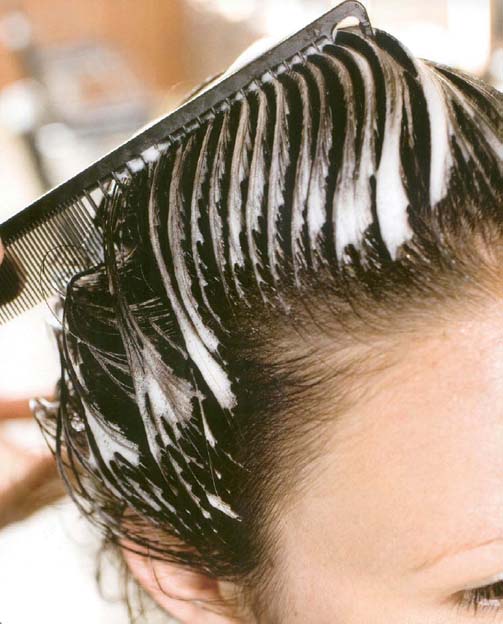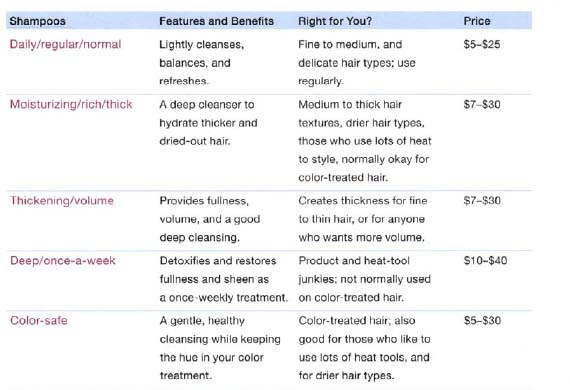1. Getting to Know Your Hair

Every day in my hair salon, women ask me to give them a haircut that is the perfect fit for their face. They’re sick and tired of having a haircut that doesn’t suit them, and because it doesn’t suit them, they spend an hour in the morning furiously trying to make it right—and failing. Just the other day, a lady having a consultation with me was convinced the shorter, more layered haircut I wanted to give her just wouldn’t suit her face, which was marginally rounded. She was sure she needed to keep her hair long, and, in fact, was close to running out of the salon. She seemed to think this was the only way to save the life of her dated hairstyle. I explained to her that a great haircut gives you beautiful face-framing shape and complements your features perfectly. But the best way to do that is to get a cut that matches the texture and shape of your hair, not the shape of your face. Going for a low-maintenance hairstyle that works with—rather than against—your natural texture and shape makes you look fresh and modern, and it is easy for you to shape and style your hair each and every day. That’s the message I give my clients and the message this book has for you.
Not every hairstyle suits every type of hair. If you choose from a range of hairstyles that match your own hair texture and shape, there will be no more fighting with your hair, no more running battles as you try to get out of the door on time in the morning, and no more spending lots of cash on the latest trendy styles that your hair just can’t handle. Instead, understand your hair texture and shape first, and then pick hairstyles to match. Not only will the style suit you better, but when you truly know your own hair type, you can choose styling techniques, products, and tools that are your perfect match, too. Knowing and playing to the strengths of your hair type allow you to create modern, sexy, and healthy no-fuss hair—and who doesn’t want that?

The lady who nearly ran from my chair understood what I could do for her, and, thankfully, she decided to stay. She had fine, fragile, long hair when she came to me. I talk about this more as I progress, but for now, fine hair is more limp and lifeless—it has less natural volume and bounce—than thicker hair types, so wearing it long only accentuated how thin and weak her hair was. As a result, that nice lady was battling with her hair every morning as she tried to give it more structure and style. Even for the best stylists this would have been a serious challenge, if not nigh on impossible. So I gave her a midlength cut with lots and lots of layers and a much softer shape, which naturally gave her hair more lift, volume, and structure. She left the salon positively gleaming, looking fresh, young, and modern. She looked that way because she had a soft-shaped haircut that suited her hair texture—not because I’d magically procured some perfect one-of-a-kind hairstyle for her very slightly rounded face. Day-to-day styling was made totally easy because she no longer had to try to create shape with long, flat, and lifeless hair.
I want the same thing for you. I want you to choose a hairstyle that matches your texture and shape, and then use the styling techniques, products, and tools that are right for you and your hair (all of which are discussed later in this book). That way you can play to your strengths, which will make you look youthful and contemporary—and all because you did the right things for your hair type!
The first step on your Great Hair journey is to figure out your hair’s natural texture and shape. Let’s tackle that right now.
Know Your Hair
After twenty-five years behind a salon chair, I can tell somebody’s hair texture and shape within thirty seconds, but for you it may be a bit trickier. Hair is, after all, quite difficult to define because it is as unique as a fingerprint. Your hair could be straight, but the texture could be fine or thick or somewhere in between (“in between" is commonly referred to as “medium-smooth" hair texture). Or it could be a curly shape and still be fine, thick, or medium-smooth in texture. And that’s not even taking into consideration the density of your hair—how many hairs you have on your head—which could be heavy, medium, or light. In other words, no matter what your hair’s texture (fine, medium-smooth, coarse) and shape (straight, wavy, curly), there’s the potential to have loads of hair or to have a light head of hair. There’s a lot of variation. Let’s simplify hair type by breaking down the different textures and shapes. Density doesn’t have as much of an impact on which styles, products, and techniques you choose, but it does highlight how unique your hair really is.
Here’s how to know your hair: Give it a good shampoo and condition, and then let it dry slowly and naturally. Every ten minutes or so, gently squeeze your hair in your hands. This helps bring out any natural wave or curl. The best time to examine your hair is when it’s completely dry. Get up close and personal with your mirror, and as you read the following sections, spend some time playing with and looking closely at your hair so you can get to know it as well as possible.

HAIR TEXTURE
Texture has to do with the diameter or thickness of the hair shaft, but if you don’t work with all types of hair every day, how can you know if your hair is fine, medium-smooth, or thick in diameter? After all, you have nothing to compare it to. And even with the thickest hair, the diameter is so tiny that you can’t take a ruler to it and measure it. However, you can determine your hair texture by paying attention to how it feels and how it falls. Take sections of hair in the front and in the back, on top and along the sides. Then look at how your hair reacts when you move it around. Does it quickly fall down flat, limp, and lifeless? Or does it stand up and puff straight out? Or does it do something in between? The more your hair falls straight down, the more it is telling you your hair is fine to medium in texture, especially if it also looks and feels lifeless and limp. Similarly, the more it likes to puff up and away from your scalp and face, the thicker the texture is likely to be. However, remember that the longer your hair is, the more likely it is to fall straight down (unless, as discussed below, your hair shape is naturally wavy or curly).
Thick hair has the widest diameter of any hair texture, noticeably wider than fine hair, and because of that it feels just a touch coarse and wiry when you run your fingers through it. It’s full-bodied, dense, and strong, and masks your scalp completely (apart from any part you put in). Other good indicators: Thick hair typically takes longer to dry naturally—around an hour or more—and tends to puff up and out, away from the scalp, rather than lying flat against your head. It’s this tendency to puff up and out, while also being dense and full of weight, that can make thick hair truly tough to manage, shape, and control. The right type of cut is essential. Short, heavily textured cuts that take the weight out give your hairstyle more shape and a lighter, looser look that is much easier to manage. (These heavily textured cuts don’t work on midlength or long hair because all that texturizing on more than three to five inches of hair looks more like a bird’s nest than a style-conscious haircut.) A long-length cut is a great alternative because long length helps weigh down thick hair so it becomes nice and straight (rather than puffing up and out as it would in a midlength cut or a shorter cut with no texture-defining layers), giving you a classic look that is easy to manage. My favorite styles for this hair type are showcased in Chapter 3, “The Ultimate Hairstyle Guide.”

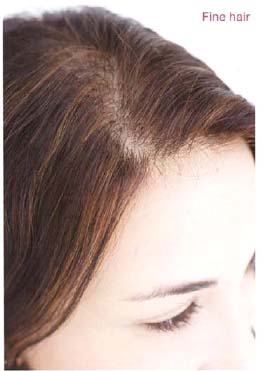
Fine hair feels thin and weak, light and fragile. It also lies flat against your head. No matter how much you try to fluff it up or spike it, it tends to fall back limply into place. Another way to tell: You can see through to the scalp even where the hair isn’t parted. If this is you, then your hair struggles to hold its shape throughout the day, which is why cuts with soft shape and soft lines work best for you. Strong styles with strong lines that are dependent on structure just don’t hold their shape and leave you looking like a mess. You can find loads of soft-shaped haircuts, perfect for finer hair types, in Chapter 3.
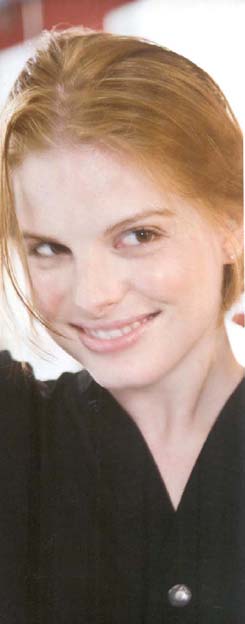
Medium-smooth hair looks and feels soft and gentle and shines quite a lot. If you run your fingers through your hair and determine it’s not fine, light, and limp, and not dense, thick, and coarse, then you have medium-smooth hair. You have the widest range of options—almost any style can, and will, work well for you. I’ve chosen a few favorites, in Chapter 3, but you can look through practically all the hairstyles in this book and decide which one is right for you.
If you’re struggling to determine your texture, compare your hair with that of a few friends or relatives. You’ll get a better picture of how much hair texture can vary. For example, you might touch your hair and think, “Well, it does feel a bit fine, but I’m just not sure.” Maybe a friend has much thicker hair, and when you touch it, that lightbulb goes on! If you’re still struggling, go into your local salon and ask for a quick consultation about your hair (there’s a lot more about hair consultations here). You don’t have to commit to anything in a consultation—it’s a free service—but you can sneak in the quick question: “So what type of hair do I have? Is it fine, medium, or thick?” Asking a professional is a sure way to get a better understanding of your hair type.
HAIR SHAPE
Your hair shape is defined by the amount of movement along the hair shaft. It falls into one of three simple categories: straight, wavy, or curly. The shape of your hair can also vary from strand to strand. It’s common to have varying degrees of movement on the same head of hair, but this shouldn’t pose any problems. If your hair varies from straight to wavy in shape, you can style your hair to be totally straight and smooth, or you can enhance your hair’s natural movement to give you lovely flowing waves. It’s all a matter of using the right styling technique. What if you’re a wavy to curly hair shape? Great. There are plenty of styling techniques to help you use the uniqueness of your individual waves and curls to define your own personal style. If instead you want straightness in curly hair, using the proper styling technique makes this a fairly simple process.
To make certain you know your hair’s shape, take hold of just one strand from the top of your head, near the crown. Grab it near the root and get really close to your mirror to examine its shape. Is it straight, wavy, or curly? If it’s straight, it won’t have any wave or wiggles, bends or curves. If it’s wavy, it’ll have smooth curves that go in one direction and then the other. If it’s curly, it’ll have a bent, twisted, or spiral shape. Now repeat this process looking at a few strands in the front, on the sides, and toward the back of your head; your hair shape can vary slightly, and in the odd case quite a lot, across the different sections of your hair. This is good to know because, for example, a lot of women have a bit more wave and movement below the crown, toward the back of the hair, than they do in the front. If you have that extra bit of movement, you can play with that wave when you’re styling to give yourself more options. I’ll talk a lot more about styling in Chapter 5, “Styling at Home.”
Framing Your Face

Your number one priority is getting a haircut that matches the texture and shape of your hair. Then, and only then, can you think about getting a hairstyle that complements the beautiful features of your face. Most important in this respect is drawing attention toward your eyes. It may be a cliché, but it’s also true: Your eyes are the windows to the soul, the focal point of your face, and your hairstyle should provide a beautiful face-framing shape. My message to you: Find a style to expose and highlight your eyes. That’s where you communicate with people and it’s where you have the most shape—the eyes, the cheekbones, the temples. Use this book to learn how to enhance these sensational features with Great Hair.
CURLY HEADS
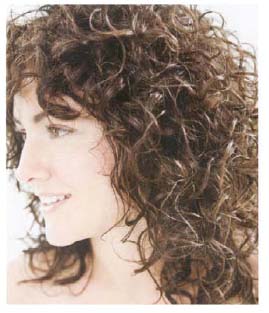
As you now know, it’s normally the texture of your hair that is the key to finding a gorgeous low-maintenance hairstyle. Knowing your shape is generally your guide to understanding your hair better and, consequently, being able to style it better. However, if you’re a true curly hair shape—you have truly spiral-shaped hair—a cut that matches the unique natural shape of your curls makes all your styling supereasy to do. (describe hair styles perfect for curly hair.)
Daily Hair Care
I hear many people obsess about shampooing their hair every day. They get freaked out because they think anything less frequent results in dirty, smelly hair that doesn’t look nice and clean. While I encourage everyone to have hygienically clean hair, shampooing three or four times weekly is plenty—shampoo every day only if you love that clean, fresh scent of just cleansed hair. If you do shampoo every day, use a lightweight shampoo formulated for daily use and rinse well to avoid buildup and residue. These result from the shampoo suds that are left on the scalp and eventually begin to dry it out, causing flakiness, which is often mistakenly self-diagnosed as dandruff. Hair washed every day with shampoo tends to need more styling product because it’s so soft, loose, and floppy, and therefore harder to style. On the other hand, one to three days of unwashed hair result in the release of natural sebum oils from your scalp (unwashed hair means hair that has not been shampooed; you can rinse your hair with plain old water, which does not contribute to residue or affect the release of natural sebum oils). Too much of those oils can leave your hair feeling greasy, but the right amount can leave your hair with a nice easy-to-manage texture for you to play with. If you’re comfortable with natural oils, try this and see how it works for you. Just be sure to brush or quickly blow out your unwashed hair in the morning to distribute the oils and to shape and define your style. Don’t use too much product, because it increases the dirt. Instead, see how you can create individual style with your own lived-in natural texture.
A final note: Some hair types—typically those with fine texture—do tend to pick up dirt and grease more quickly and may look a little too dirty to go a full three days without shampooing, but you can determine how far to push this envelope by simply looking at your hair in the mirror and making a decision to shampoo or not, based on your own preferences.
The Proper Technique for Shampooing and Conditioning Your Hair
The technique for shampooing is the same for all hair types, although the type of shampoo you use varies depending on your hair type. (See the shampoo and conditioner table for more help.) First, squeeze a dime-sized dab of shampoo in the palm of your hand. Then rub your palms together to create a nice lather before applying the shampoo to your hair. Next, spread the shampoo evenly throughout your scalp. The most common mistake is putting a big dollop of shampoo in the palms, not lathering it up, and whacking it straight onto the top of the head, then furiously trying to rub the product all over. This causes friction and damage to the cuticle (the cuticle is the outer layer of your hair shaft, the bit you can touch and see), which leads to frizz. You need to distribute the shampoo evenly. So lather up first in your palms, then apply the shampoo from below the crown and gently distribute through the rest of your hair while massaging—not rubbing—your scalp with your fingertips. In addition to being the best way to clean your hair and scalp, this massage is a nice relaxing treat.
As for conditioner, there’s a lot of confusion out there as to how often you need to use it. A lot of people say that you don’t need to condition nearly as often as you shampoo. That’s just plain wrong. I can only assume that this false notion is a result of the deeper, once-a-week conditioning treatments that are now on the market. If you’re not using one of the weekly treatments, you should condition your hair more often than you shampoo because it’s conditioner that gives you texture, moisture, and shine, all vital to lovely, luscious hair. Rinse your hair with water and then, while still in the shower or bath, apply and rinse out your conditioning product. Conditioner not only makes your hair look and feel softer and smoother, it also calms your hair down, making it easier to shape and style. For that reason it’s beneficial to condition more often than you shampoo—it can be done every day if you have the time and inclination.
When applying conditioner, there’s no need to overcondition the roots. Your roots are much healthier because that’s where all new hair comes in. Instead of religiously trying to work conditioner through the roots, rub the product in your palms (it won’t emulsify and lather like shampoo because it doesn’t have the suds) and then focus your conditioning at the ends, especially when hair is more than three inches long. Focus on massaging the conditioner thoroughly through the final three inches of your hair shaft in sections all across your hair. Doing this regularly truly does make an incredible difference. Just like with shampoo, the technique is the same for all hair types, but the type of conditioner varies according to your hair. One further point: Light, leave-in, or daily conditioners can be left in the hair (they don’t need to be rinsed out) to add a little more softness, smoothness, and shine— and if the conditioner has a nice scent, that’s a bonus. Make sure you rinse out thicker, more moisturizing conditioners because they weigh down the hair if they are left in.
The Proper Technique for Towel Drying Your Hair
It’s best to towel-dry hair to damp (and thus ready for blow-drying and styling). But you might be surprised at how many clients come into my salon complaining of frizz and have no idea why they’re stuck with this style-destroying problem. As you’ll learn in Chapter 5, lots of women get frizz from using an incorrect styling technique. But this also happens when you do not towel-dry your hair properly. Many people whack the towel on their head and rub, rub, rub until it’s damp, almost dry. Your hair will get dry with this method, but it’s also sure to get damaged in the process.
The right way to towel-dry your hair to damp is to use your towel to gently squeeze each and every section of your hair. Move your head left and right, up and down, and gently squeeze, squeeze, squeeze until your hair is damp, not wet. Remember the last time you were at the salon, and your shampoo guy or gal gently massaged your hair with the towel after washing it? Well, that’s just how you should do it every day. Rubbing your hair with a towel instead of using this squeezing technique definitely roughs up your hair cuticles. (Remember, the cuticle is the outside portion of the hair shaft, the bit you see.) By roughing it up, you’re much more likely to create frizz. With curly hair, it’s better to let it dry naturally rather than use a diffuser or a blow-dryer all the time, which is what a lot of curly heads do. It’s true that the more you blow-dry and diffuse genuinely curly hair, the more you can get volumized curls, but it’s also true that there’s a big probability of getting flyaways and frizz. Learn to style your curly hair as you let it dry naturally, allowing it to separate into a natural curl formation (see here for more details on this great technique).
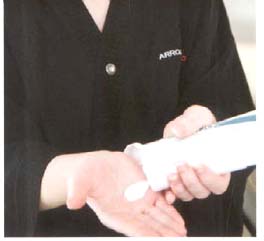
SHAMPOOS AND CONDITIONERS: WHICH ONE’S FOR YOU?
With so many shampoos and conditioners on the market, it can be a challenge to find the one that’s right for you. Should you use daily, light, leave-in, moisturizing, or thickening products? The table on the next page explains the different features and benefits of shampoos and conditioners and what those features and benefits mean for you.
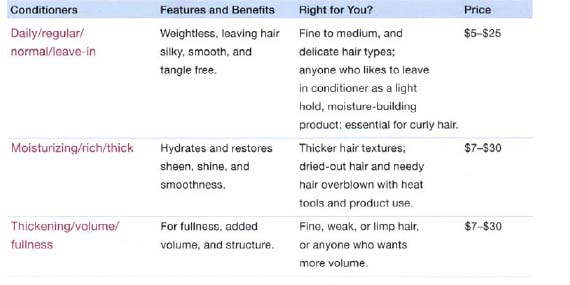
Golden Guidelines
I’m not one for hard-and-fast rules for anybody. Life is too short for that. Having said that, there are some golden guidelines you can use to help you on your Great Hair journey. I often mention these to my clients to keep them one step ahead of the game.
Healthy hair is your number one goal. Buy shampoo and conditioner that are right for you and your hair type, and always follow the proper technique.
There’s a new trend that says you should get your hair cut every four weeks instead of the traditional six to eight weeks. I don’t believe this for one second and neither should you. Unless your hair is supershort, and you like to keep it that way, getting your hair cut once a month is a waste of your money. A good haircut should last a minimum of six weeks before needing a cut.
Fuller-figured women often bring their hair forward over the face, mistakenly believing this will hide their fuller shape. It doesn’t. Bringing hair forward to the cheeks actually draws attention to the fullest part of anybody’s face: chubby cheeks! Instead of trying to disguise your shape and size, be brave—style your hair back away from your face, expose your eyes, and get the twinkle back.
I can’t stress enough the importance of great bangs. Bangs cut wrong make your eyes look closer together, or they can weigh you down into a heavy, old-fashioned look. Bangs cut right lift you up, frame the wonderful features of your face, and bring more attention to your eyes. Be brave and try gorgeous new bangs. (There are lots of beautiful bang-enhanced haircuts in Chapter 3, “The Ultimate Hairstyle Guide.")
Calling out fashion faux pas is all the rage. Never wear white before Memorial Day or after Labor Day is an enduring one that makes me giggle. It’s just not true. If you look great, who cares what date it is? It’s the same with hair: Don’t wear long hair over forty, people say. I disagree. As long as your hair is healthy, the style is modern, and it suits you, wear any length you want, regardless of your age.
When combing out tangles in your hair, always comb from ends to roots. Start by combing through the final two to three inches of your hair—the ends of your hair shaft—and comb through to the tips. Then work your way up, combing through the next three inches or so, and continuing like this until you reach your roots. If you start at the roots and work through to the ends—the opposite direction to the correct technique just outlined—you can push all the knots in your hair together into one big tangled mess. Combing from ends to roots in easy-to-manage sections gives you your best chance to untangle any unruly knots.
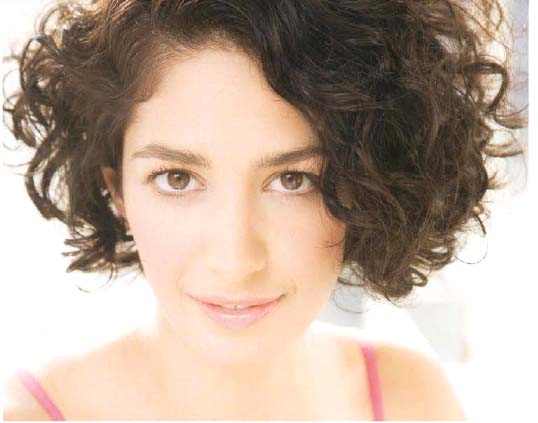
The longer your hair, the more weight it has. And more weight pulls your hair down into a straight shape. In other words, if you have a slight wave or kink in your hair, the longer you wear it, the more that wave or kink falls flat, straight, and smooth. So if you want to play into the kink, go shorter; if you want a straighter, smoother look, go longer.
If you tie your long hair back almost every day, this can affect how the hair behaves. Hair tied back daily often wants to puff up and stand straight out. What do I mean? Well, when you take your hair out of a ponytail, it is naturally a bit more stand-straight-out than lie-down-nice-and-flat, but it should, after a short time, start to lie down fairly flat. If it doesn’t, it’s a sign that your hair has adjusted to that shape, so getting it to lie down is a challenge. If you think this is happening to you, and you’re thinking about a brand-new cut, I advise you to stop tying your hair back for four to six weeks beforehand. This gives your hair time to go back into its natural shape, and it won’t surprise you when you get that gorgeous new style.
If you’re considering a new hairstyle, put your priorities in order. Numbers one, two, and three are the potentials of your hair. What hairstyles can your hair most naturally achieve to give you your best chance to create gorgeous, fun hair with minimal fuss? This is how I approach every single haircut for every single client. It’s the key to my success, and I’m sure it’ll be the key to your success, too. (There’s a lot more help on shapes and styles to suit each individual in Chapters 2 and 3, so if you’re getting excited about trying a new you, those are great places to start.)
I encourage you all to keep changing and adapting the way you look. Change invigorates us and makes us feel younger, more confident, sexier, healthier, more vibrant, and more modern. I certainly suggest taking a good look at your hairstyle every year and asking yourself if it’s time for an inspirational new you.
No matter what your hair type, your everyday challenges, whether you have out-of-control frizzies, dry, damaged hair, wild flyaways, unmanageably thick hair, fine, fragile hair, or even an unusual combination of all the common problems, there’s a 100 percent chance of achieving a look you love, especially when you start by getting the right style for your hair type.
Summing It All Up
Chapter 1 of your Great Hair journey is all about getting to know and understand your own hair type. You should now know your own hair’s shape and texture and the important role that plays in finding the right hairstyle for you. If your hair has fine texture, look for a haircut and style that create volume and thickness and life in your hair. If your hair has medium-smooth texture, you now know that most hairstyles suit you perfectly well and you can begin to think about your own preferences. If your hair has thick texture, you know that you’re looking for a hairstyle that creates space and freedom, and that defeats the puffiness and bulk that can cause problems for you. If your hair shape is naturally curly, you want a cut and style that celebrate your curls by playing into the strengths of your unique hair type. Whatever your type, picking a style that suits your own texture and shape gives you your best chance of getting a modern, style-defining haircut that beautifully frames the features of your face.
By now you are aware that different hair types (and different people) need different shampoos and conditioners, and choosing the right combination for you plays an important part in the overall integrity of your hair. Get this simple element right and you have a great foundation for moving forward with Great Hair.
Finally, my Golden Guidelines and my refutation of the major myths and legends surrounding hair care will help keep you on the straight-and-narrow road to successful style.
Old Wives’ Tales
There are many misguided ideas about hair. Mistaken beliefs about what you should and shouldn’t do have been circulating in homes and around the hair salons of the world for centuries. They may appear harmless and even quite comforting, but the misguided gospel they teach does affect your ability to create Great Hair. We definitely don’t want that, so let’s cut through the myths and the legends.
Hair Grows Faster If You Trim It
I’m sure this myth comes from the fact that trimming ends makes your hair look healthier. That is true because you’re cutting off all those nasty split ends, but hair grows at the same rate no matter how often you cut or trim it. If you’re trying to grow your hair longer, wait a bit longer in between cuts. Wait until your hair has grown three inches and then ask your hairdresser to cut off an inch. You have two more inches than when you started growing it, and by cutting off an inch, you give your hairdresser the opportunity to cut in some shape and style. Continue this process until your hair reaches your desired length. Not only is your hair now nice and long, but its health is in tip-top shape, too.
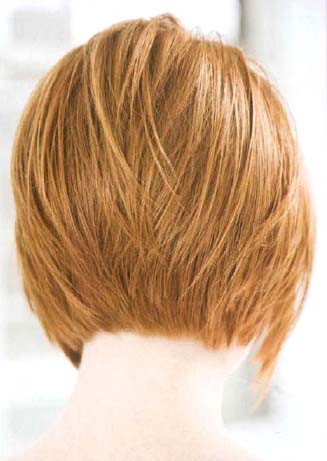
Cutting Your Hair Short Makes It Thicker
No, it doesn’t. Cutting hair short gives the illusion of thickness. When hair is on the longer side, the extra weight pulls it down, making it look fine and thin. Conversely, short hairs lie on top of each other and with that comes the illusion of thicker hair. If you have fine or thinning hair, a shorter style might be just the ticket.
Product Doesn’t Make a Difference
Unless you have a crew cut or a shaved head, product does make a great difference in styling. Without product, clean hair is definitely less easy to style. But you don’t need a hatful of products to make your hair work. Of course, you can have fun trying lots of products and experimenting with what works best for your hair, but you really need only a small selection of products that work well for you.
Think about your styling products in two categories. Category one consists of some foundation-building products, and category two features one or two products that give a fabulous finish to your look. Your foundation product—for example, volumizing foam, styling créme, texturizing paste, or hair crémes or lotions—creates shape and structure; finishing products like shine spray, holding spray, or hair spray add the final dazzling touches and/or hold your look in place. First and foremost, use products that work for you, but I also advise trying to find complementary products from the same product line. Good-quality styling lines are designed to work together and the fragrances will be complementary, too. (There’s more on choosing the right styling products for you here.)
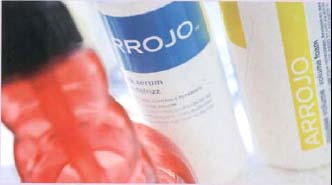
Color Treatments Thicken Your Hair
A chemical color treatment won’t thicken your hair, but it may alter the texture slightly. When color is deposited, it can—especially if it’s a radical color change like bleaching—expand your hair shaft temporarily, adding an extra dimension of fullness that gives you thicker texture, more volume, and more grip (what I mean is that the hair “grips" onto pins more easily—great for when you’re pinning your hair back or into an updo). Play into this illusion of thickness by putting a bit more hold and volume into your blow-dry. But color only if you want new color, not for thickness, because only the color can be guaranteed; the added texture can’t. If you find a bit of added texture after coloring, it’s a bonus, and make as much out of it as you can! Remember, color adds depth and richness to the texture because it reflects light in a more flattering way, again giving the illusion your hair is full and thick.


